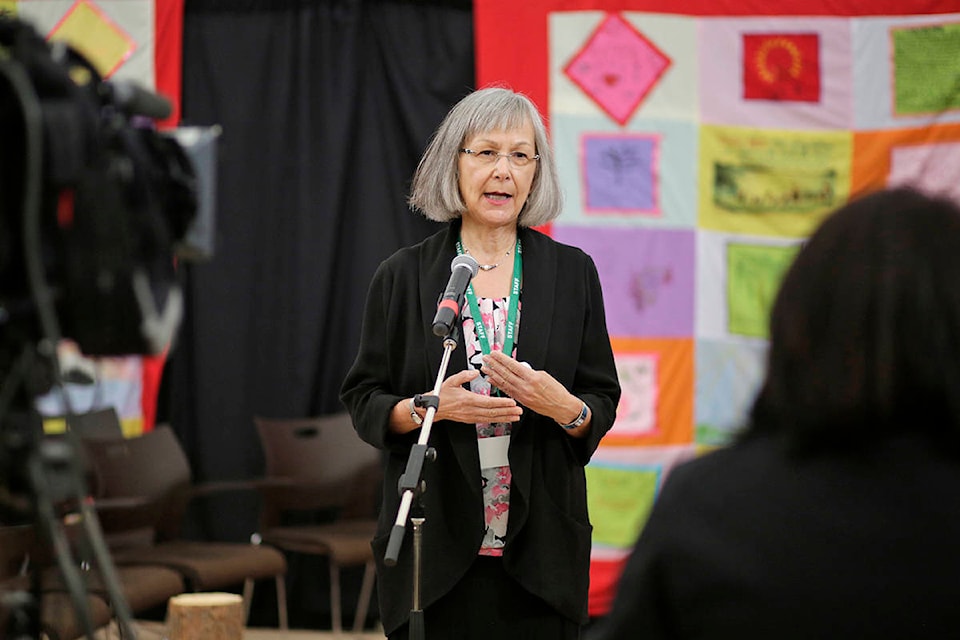Survivors and families of missing and murdered Indigenous women and girls are preparing for what’s anticipated to be a highly emotional ceremony in Gatineau, Que., on Monday to mark the release of a report that names the issue as nothing short of a “genocide.”
In the final report, chief commissioner Marion Buller says the that national inquiry had a short time to do its work but within that period, survivors provided “important truths.”
“These truths force us to reconsider where the roots of violence lie, and in doing so, to reconsider the solutions,” she writes.
“I hope that knowing these truths will contribute to a better understanding of the real lives of Indigenous people and the violations of their human and Indigenous rights when they were targeted for violence.”
Canadians live in a country whose laws and institutions perpetuate violations of these rights, Buller adds, noting they “amount to nothing less than the deliberate, often covert campaign of genocide.”
“This is not what Canada is supposed to be about,” she says. “It is not what it purports to stand for.”
The findings of the federally-funded inquiry are contained within a massive document that focuses on legal issues including policing and the need to effectively respond to human trafficking cases, sexual exploitation and violence, including in the sex industry.
It also stresses the need to ensure that failures in policing, health services and child welfare are not brushed off as failures of the past.
“The reality is that many of the people who testified before the national inquiry have lived through, and continue to heal from, these policies,” the report says.
“Many more people are in current conflict with them.”
READ MORE:
Throughout the course of its mandate, the inquiry has faced numerous challenges.
It was plagued by headlines about staff turnover: two executive directors and its director of research left, and so did lawyers, community-relations workers, and numerous communications staff.
A Metis commissioner from Saskatchewan, Marilyn Poitras, abruptly announced her resignation in July 2017, citing concerns about the commission’s structure.
In response to Poitras’s resignation, a number of families and advocates called for a reboot of the commission, but Buller maintained the body would remain focused on completing its “tremendously important work.”
For its part, the federal government sidestepped calls for a re-set. It’s now looking ahead at the report’s release.
Crown-Indigenous Relations Minister Carolyn Bennett, who would not speak to the specifics of the report ahead of its public release, said in an interview that the final document is not the end of the journey.
The federal government will now have to up its game in terms of “racism and sexism in policing” and all institutions, as well as accelerate progress on child welfare reforms, she said.
During the government’s pre-inquiry sessions ahead of the inquiry’s launch, Bennett said the government heard “time and time again” about a legal system that wasn’t working for Indigenous women and girls — from reporting to police, to being taken seriously, to the way searches were conducted, to the charges that resulted or didn’t.
Similar issues were raised during the course of the Truth and Reconciliation Commission’s work.
The former chairman of the commission that reported on the legacy of Canada’s residential schools, Sen. Murray Sinclair, said his commission heard from numerous women who had been victimized sexually in residential schools who felt they weren’t believed by police.
“They were of the view that the officer not only didn’t believe them but he, and it was almost always a male, was disrespectful towards them,” Sinclair said in a recent interview.
Independent MP Jody Wilson-Raybould, who was Canada’s first Indigenous justice minister when the inquiry was launched, said in a recent interview that she anticipates the report will raise the awareness about the ongoing tragedy.
She hopes the report and recommendations will be seriously considered, she said, adding there’s no question there are systemic barriers, including racism and bias, in institutions.
“There needs to be justice for Indigenous women,” she said.
Families of victims, survivors and advocacy organizations, like the Native Women’s Association of Canada, have been calling for years for an inquiry. There has also been a desire for answers on the magnitude of the problem.
In 2005, the association created a database tracking cases and produced a 2010 report documenting 582 missing and murdered Indigenous women.
In 2014, the RCMP released a national overview and pegged the number at nearly 1,200 between 1980 and 2012.
The final report says that despite best efforts to gather information related to missing and murdered Indigenous women and girls, it concludes that “no one knows an exact number.”
READ MORE:
Kristy Kirkup, The Canadian Press
Like us on and follow us on .



